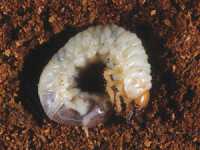Pest Of The Month: White Grub

Identification
May beetle larvae are white with a C-shape body, brown head, and three pairs of legs. Two parallel rows of spines seen on the underside of the last abdominal segment distinguish true white grubs from similar-looking larvae. The length varies from 1 to 2 inches.
The pupa is colored white or faint yellow. The small, spherical, pearly white eggs can be found encased in soil aggregates. Eggs darken just before hatching.
White grub life cycles vary somewhat between species from one year to as many as four years. Young larvae feed upon roots and decaying vegetation throughout the summer and in the autumn, when they migrate downward and remain inactive until the following spring.
Survival And Spread
At this point in the insect’s life cycle, the greatest amount of damage occurs as the larvae return near the soil surface to feed on the roots of the plants. The next autumn the larvae again migrate deep into the soil to overwinter, returning near the soil surface the following spring to feed on plant roots until they are fully grown. Although white grubs can be a problem every year, the most serious damage occurs in regular three-year cycles, with greatest damage to crops the year after the appearance of the adults.
Management
Late spring or early autumn plowing destroys many larvae, pupae, and adults in the soil and also exposes the insects to predators, such as birds. For this practice to be effective, plowing must occur before the grubs migrate below the plow depth. Natural enemies that control these white grubs include a number of parasitic wasps and flies. Inoculating the soil with bacteria Bacillus popilliae Dutky and B. lentimorbus Dutky spores aids in reducing populations. Soil-applied insecticides such as Imidan (phosmet, Gowan Co.) are also effective.










